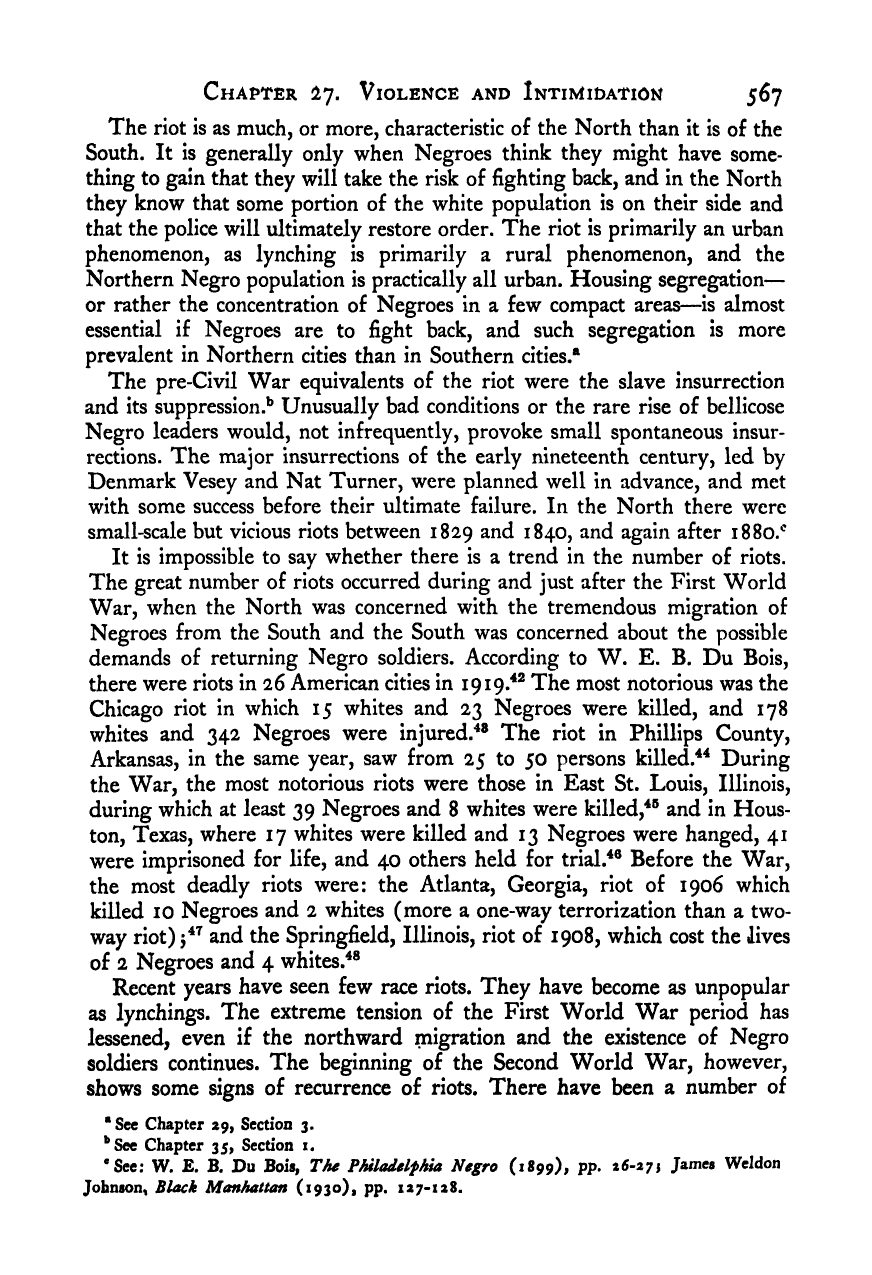Note: Gunnar Myrdal died in 1987, less than 70 years ago. Therefore, this work is protected by copyright, restricting your legal rights to reproduce it. However, you are welcome to view it on screen, as you do now. Read more about copyright.
Full resolution (TIFF) - On this page / på denna sida - VI. Justice - 27. Violence and Intimidation - 5. Riots

<< prev. page << föreg. sida << >> nästa sida >> next page >>
Below is the raw OCR text
from the above scanned image.
Do you see an error? Proofread the page now!
Här nedan syns maskintolkade texten från faksimilbilden ovan.
Ser du något fel? Korrekturläs sidan nu!
This page has never been proofread. / Denna sida har aldrig korrekturlästs.
Chapter Violence and Intimidation 567
The riot is as much, or more, characteristic of the North than It is of the
South. It is generally only when Negroes think they might have some-
thing to gain that they will take the risk of fighting back, and in the North
they know that some portion of the white population is on their side and
that the police will ultimately restore order. The riot is primarily an urban
phenomenon, as lynching Is primarily a rural phenomenon, and the
Northern Negro population is practically all urban. Housing segregation
—
or rather the concentration of Negroes in a few compact areas—is almost
essential if Negroes are to fight back, and such segregation is more
prevalent in Northern cities than in Southern cities.*
The pre-Civil War equivalents of the riot were the slave Insurrection
and its suppression.^ Unusually bad conditions or the rare rise of bellicose
Negro leaders would, not Infrequently, provoke small spontaneous insur-
rections. The major insurrections of the early nineteenth century, led by
Denmark Vesey and Nat Turner, were planned well in advance, and met
with some success before their ultimate failure. In the North there were
small-scale but vicious riots between 1829 and 1840, and again after 1880.’^’
It is impossible to say whether there is a trend in the number of riots.
The great number of riots occurred during and just after the First World
War, when the North was concerned with the tremendous migration of
Negroes from the South and the South was concerned about the possible
demands of returning Negro soldiers. According to W. E. B. Du Bois,
there were riots in 26 American cities in 1919.’*^ The most notorious was the
Chicago riot in which 15 whites and 23 Negroes were killed, and 178
whites and 342 Negroes were Injured.**® The riot in Phillips County,
Arkansas, in the same year, saw from 25 to 50 persons killed.^^ During
the War, the most notorious riots were those in East St. Louis, Illinois,
during which at least 39 Negroes and 8 whites were killed,^® and in Hous-
ton, Texas, where 17 whites were killed and 13 Negroes were hanged, 41
were Imprisoned for life, and 40 others held for trial.^® Before the War,
the most deadly riots were: the Atlanta, Georgia, riot of 1906 which
killed 10 Negroes and 2 whites (more a one-way terrorization than a two-
way riot) and the Springfield, Illinois, riot of 1908, which cost the lives
of 2 Negroes and 4 whites.**®
Recent years have seen few race riots. They have become as unpopular
as lynchings. The extreme tension of the First World War period has
lessened, even if the northward migration and the existence of Negro
soldiers continues. The beginning of the Second World War, however,
shows some signs of recurrence of riots. There have been a number of
“See Chapter 29, Section 3.
*’See Chapter 35, Section i.
•See; W. E. B. Du Bois, T/te PAiladelfhia Negro (1899), pp. 26-275 James Weldon
Johnson, Black Manhattan (1930), pp. 127-128.
<< prev. page << föreg. sida << >> nästa sida >> next page >>